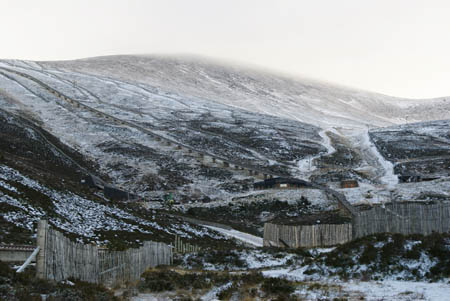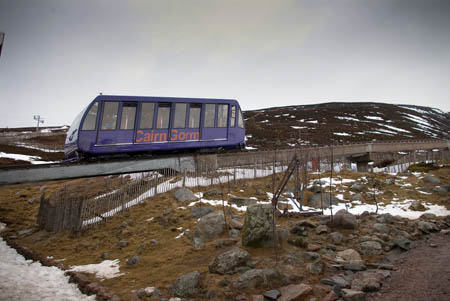The Cairngorm funicular, opposed by many walkers and conservationists at its inception, went ahead despite a weak business case, evident even before construction started.
The controversial railway ended up in public ownership in May 2008 after Highlands and Islands Enterprise stepped in to stop the project folding. The cost of the railway, built to serve the skiers in the corries of Cairn Gorm, cost £19.5m, almost £5m more than expected; a further £7m has been pumped into the project to keep it going.
The findings were published today in a report by Audit Scotland. The funicular started operating in 2001, despite a concerted campaign against its construction by the Cairngorms Campaign.
The Auditor General for Scotland, Robert Black, said: “When the Cairngorm funicular was first considered it was seen as key to regeneration of the area, and was expected to contribute to increased tourism and job creation. Many of the expected benefits have been realised. However, Highlands and Islands Enterprise did not fully take account of new risks that emerged early on in the project, and the construction of the funicular cost about one-third more than expected.
“HIE has taken over the funicular and operator and is now developing a new business model. In doing this, the agency must learn from its experiences to date. It must fully assess the risks, review the current performance and develop clear objectives.”
The number of skiers using Scottish resorts, including the CairnGorm Mountain slopes, has been declining since the late 1980s from a high of almost 350 skier-days in 1988 to just over 50 last year. Climate change and cheap flights have hit visitor numbers, although CairnGorm Mountain has responded by boosting summer visits. However, a stipulation of EU funding of £2.9m is that visitors must be prevented from accessing the mountain from the top station outside of the main skiing season, to protect the fragile summit environment.
The funicular must operate for at least 25 years or the EU grant will have to be repaid.

Visitors cannot use the funicular to access the summit outside of the skiing season. Photo: Geoff Wong ![[CC-2.0]](/lib/img/layout/cc-attr.gif)
The report says Cairngorm Mountain Limited, the company that operated the funicular, struggled financially since the opening of the railway, culminating with the takeover last year of the firm by Highlands and Islands Enterprise, a public body.
From the outset, the report says, HIE was aware of risks facing the project, including climate change; the complexity of the project and its environmental requirements; CML’s weak financial position; the need to reinstate the land and dismantle the railway if skiing stopped, and the low level of private-sector funding. Only £2.5m of the initial investment came from CML itself, and this was in the form of a bank loan.
During building of the project, CML encountered further financial problems and HIE provided extra cash, taking over ownership of the assets with CML as the tenant.
By 2004, the enterprise board had reduced rent from more than £½m a year to £100,000 ‘to better reflect the commercial potential of the buildings’.
Total public investment in the Cairngorm funicular now stands at £23m. Even now, Audit Scotland says, “It is possible that the predicted income from non-skiing visitors in the business case may have been overstated.”
The investigation also points out that a consultants’ report commissioned by HIE, due to be published in March, was delayed until September this year and had still not been seen by the time Audit Scotland produced its paper. The consultation is due to be discussed at the HIE board meeting in December.
In May this year, Ramblers Scotland called for a halt on any further public money for the project. Director Dave Morris said: “HIE should not be allowed to invest any more public money in it until that investigation [by Audit Scotland] has been completed and the Scottish Parliament has had the opportunity to scrutinise its findings.
“An absolutely huge sum of public money has been spent on this, but when it started its life it was supposed to have been private-sector led. We always held it was built in the wrong place.
“The top station should have been at the lower end of the Ptarmigan Bowl, away from the European designated sites, then they might not have had to have a closed system which prevents people getting out at the top. It might have succeeded then.”
Cairn Gorm’s Northern Corries provide some of the best winter climbing in Scotland, including Coire an-t Sneachda and Coire an Lochain. Coire Cas, at the head of the funicular, also provides access to the 1,244m (4,081ft) Cairn Gorm plateau.
